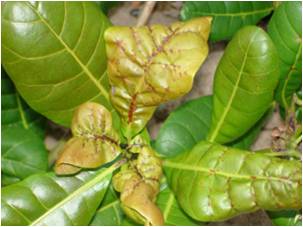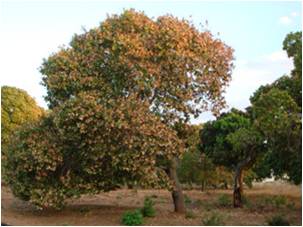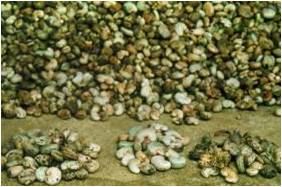
| Home |
Cashew |
| 1. Stem and Root Borer |
| 2. Tea Mosquito Bug |
| 3. Leaf Miner |
| 4. Shoot and Blossom Webber |
| 5. Apple Borer |
| 6. Inflorescence Caterpillar |
| 7. Thrips |
| 8. Bark Borer |
| 9. Slug Caterpillar |
| 10. Leaf Feeder |
| 11. Looper |
| 12. Apple and Nut Borer |
| Questions |
| Download Notes |
Pests of Cashew :: Major Pests :: Tea mosquito bug
2. Tea mosquito bug: Helopeltis antonii (Miridae: Hemiptera)
Distribution and status: Karnataka, Goa, Maharashtra and Tamil Nadu
Damage symptoms
|
|
 |
 |
 |
 |
Nymphs and adults suck sap on leaves and inflorescence. Leaves are deformed and show angular lesions, particularly along the veins, which may drop off. In flowering stage cause inflorescence blight. Feeding on the stalks of the tender shoots causes elongated green lesions, sometimes accompanied by exudation of gum. Severely damaged shoots die back due to the effect of bug saliva in combination with fungi, which enter the plant tissue through the feeding lesions; the subsequent development of numerous auxiliary buds causes a bunched terminal growth known as 'witches broom'. In case of serious infestations the trees may appear as if scorched by fire. Bug feeding on developing apples and nuts causes brown sunken spots. The growth of trees is seriously retarded and fruit formation of attacking flowering shoots is reduced.
|
|
| Bionomics | |
 |
 |
Female inserts 82 eggs into epidermis of tender shoot, axis of inflorescence and nodes. Eggs are elongate and slightly curved with a pair of filaments, egg period 7-8 days. Nymphal period 14-16 days. Life cycle completed in 22-25 days. Adult is a reddish brown bug with black head, red thorax, black and white abdomen, and a knob like process on mid-dorsal thorax.
Management
iii Do not interplant cashew with crops that are host for Helopeltis bugs, such as cotton, tea, sweet potato, guava and mango |
|